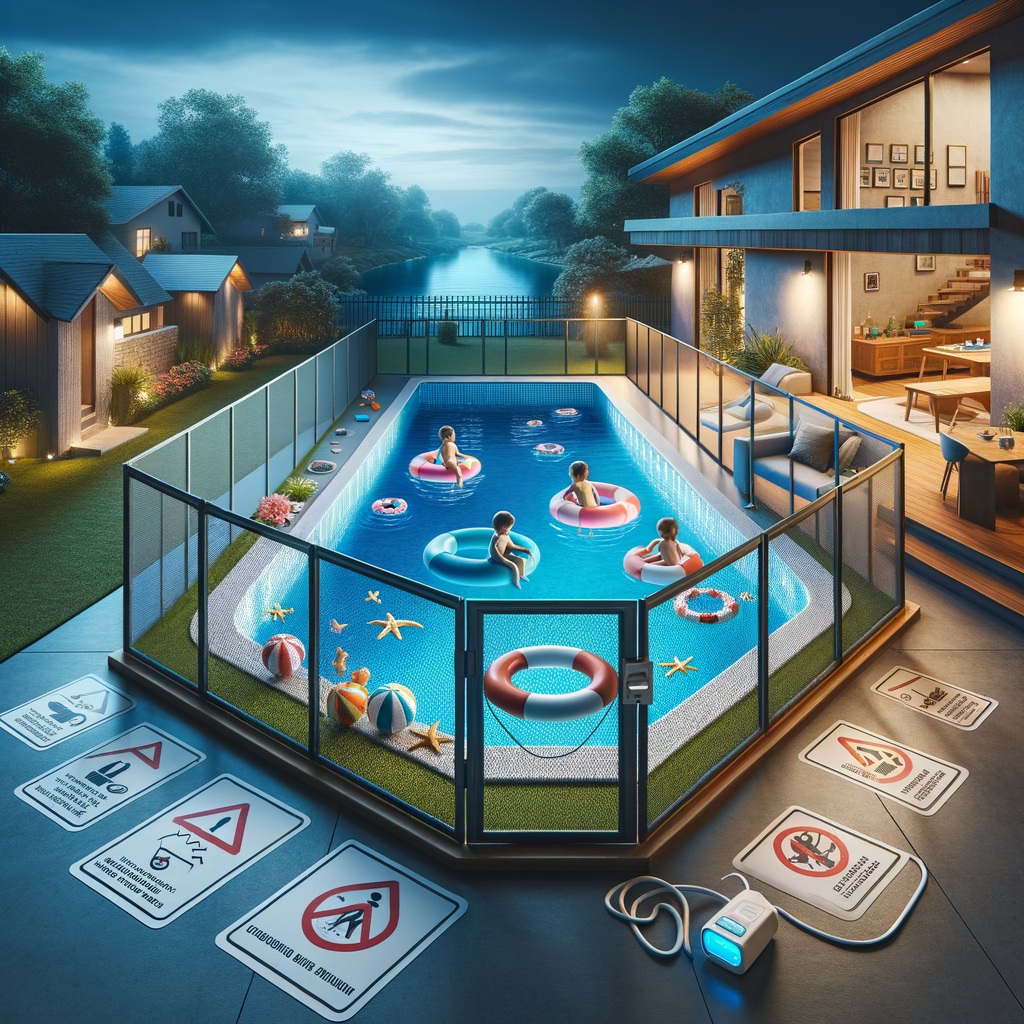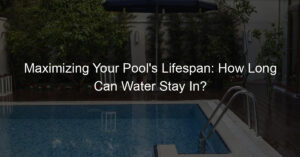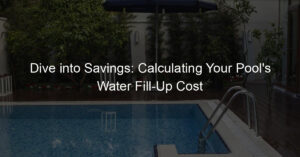
Introduction to Childproofing Pools
Having a swimming pool at home can be a great source of fun and relaxation. However, it’s important to remember that pools can also pose a risk, especially to young children. That’s why it’s crucial to understand the importance of pool safety and take the necessary steps to childproof your pool.
- Understanding the Importance of Pool Safety
- Statistics on Pool-Related Accidents
First and foremost, pool safety is all about preventing accidents. Children, especially those under the age of five, are naturally curious and may not understand the dangers associated with a pool. Without proper precautions, they can easily fall in and potentially drown. Childproofing your pool is not just about keeping your kids safe, it’s about providing a safe environment for everyone who visits your home.
According to the Centers for Disease Control and Prevention (CDC), drowning is the second leading cause of accidental death for children aged 1-14 years. Furthermore, for every child who dies from drowning, another five receive emergency department care for nonfatal submersion injuries. These statistics highlight the urgent need for pool safety.
| Age Group | Number of Drowning Deaths (Annual) |
|---|---|
| 1-4 years | 390 |
| 5-9 years | 76 |
| 10-14 years | 48 |
These numbers are a stark reminder of the importance of childproofing pools. It’s not just about preventing accidents – it’s about saving lives.
In the following sections, we will delve deeper into the basics of kid-safe pools, advanced measures for home pool safety, and how to maintain and upkeep your pool for maximum safety. We will also discuss the importance of rules and supervision in ensuring pool safety, and look beyond the pool to other areas of the home that need childproofing. Stay tuned to learn more about creating a safe and enjoyable pool environment for your children.
Kid-Safe Pools: The Basics
Ensuring the safety of your children around the pool is of utmost importance. One of the most effective ways to do this is by installing a pool fence. Let’s delve into the basics of pool fencing.
Pool Fencing
Pool fencing is a crucial safety measure that prevents children from accessing the pool area unsupervised. It serves as a physical barrier that can save lives.
- Importance of Pool Fencing
- Choosing the Right Fence
Pool fencing is not just an optional accessory; it’s a vital safety feature. According to the U.S. Consumer Product Safety Commission, approximately 350 children under five years old drown in pools each year. Most of these incidents happen in home pools. A pool fence can significantly reduce these unfortunate incidents by providing a barrier that restricts children’s access to the pool.
When it comes to choosing the right fence, there are several factors to consider. The fence should be at least four feet high to prevent children from climbing over it. It should also have a self-closing and self-latching gate for added safety. The design of the fence is also important. It should not have any footholds or handholds that children can use to climb. The spaces between the fence slats should be small enough to prevent children from squeezing through. Lastly, the material of the fence should be durable and resistant to weather conditions.
In conclusion, pool fencing is a basic yet essential safety measure for kid-safe pools. It provides a physical barrier that keeps children away from the pool area, reducing the risk of drowning incidents. When choosing a pool fence, consider its height, gate features, design, and material to ensure it effectively serves its purpose.
Pool Covers
When it comes to keeping your pool safe for kids, pool covers are a must-have. They not only provide safety but also have many other benefits. Let’s dive into the world of pool covers and see how they can help us.
- Benefits of Pool Covers
Pool covers are more than just a safety measure. They offer a range of benefits:
- Prevent Accidents: A sturdy pool cover can prevent children and pets from accidentally falling into the pool.
- Save Energy: Pool covers help to reduce the amount of heat lost from the pool, saving energy and reducing your heating costs.
- Keep the Pool Clean: They keep leaves, dirt, and other debris out of your pool, reducing the need for cleaning and maintenance.
- Reduce Water Evaporation: By covering the pool, you can reduce water evaporation by up to 95%, saving water and money.
- Types of Pool Covers
There are several types of pool covers available, each with its own advantages and uses:
- Safety Covers: These are designed to prevent accidental falls into the pool. They are sturdy and can support the weight of a child or pet.
- Solar Covers: These covers help to heat the pool using the sun’s energy, reducing your heating costs.
- Winter Covers: These are used to protect the pool during the winter months. They are strong and durable, preventing debris and harsh weather from damaging the pool.
- Automatic Covers: These covers can be opened and closed with the push of a button, making them convenient and easy to use.
Choosing the right pool cover depends on your needs and the specific features of your pool. Remember, safety should always be your top priority.
Home Pool Safety: Advanced Measures
When it comes to ensuring the safety of your home pool, there are several advanced measures you can take. One of these measures is the use of pool alarms. In this section, we will explore the different types of pool alarms and provide a simple guide on how to install them.
Pool Alarms
Pool alarms are essential safety devices that alert homeowners when there is unexpected activity in the pool. They are particularly useful in preventing accidents and ensuring the safety of children and pets.
- Types of Pool Alarms
- Surface wave detection alarms are triggered when something disturbs the water surface.
- Subsurface detection alarms detect disturbances below the water surface, making them more accurate than surface alarms.
- Personal immersion detectors are worn by the swimmer and trigger an alarm when immersed in water.
- Gate and door alarms are installed on the pool gate or door and sound an alarm when the gate or door is opened.
- How to Install Pool Alarms
- Choose the best location for your alarm. It should be easily heard from inside the house.
- Follow the manufacturer’s instructions to mount the alarm. This usually involves attaching the alarm to the pool deck or fence.
- Test the alarm to ensure it is working correctly. This can usually be done by creating a disturbance in the pool and checking if the alarm sounds.
There are four main types of pool alarms: surface wave detection alarms, subsurface detection alarms, personal immersion detectors, and gate and door alarms. Each type has its own unique features and benefits.
Installing a pool alarm is a relatively straightforward process. However, the installation process may vary slightly depending on the type of alarm. Here is a general guide:
Remember, pool alarms are not a substitute for active supervision. They are an additional layer of protection to help keep your pool safe.
Pool Safety Nets
When it comes to advanced measures in home pool safety, one cannot overlook the importance of pool safety nets. These nets serve as a protective barrier, preventing accidents and ensuring a safe swimming environment for children.
- Benefits of Safety Nets
Pool safety nets offer numerous benefits. Let’s delve into some of them:
- Prevention of Accidents: The primary purpose of a pool safety net is to prevent accidental falls into the pool, especially for children and pets.
- Easy to Use: Safety nets are user-friendly. They can be easily installed and removed when necessary.
- Durable: These nets are designed to withstand weight and weather conditions, making them a long-lasting safety measure.
- Non-obstructive: Unlike fences or covers, safety nets do not obstruct the view of your pool, maintaining the aesthetic appeal of your backyard.
- Installation of Safety Nets
Installing a pool safety net is a straightforward process, but it requires careful attention to ensure maximum safety. Here’s a simple step-by-step guide:
- Measure Your Pool: Start by measuring the dimensions of your pool to determine the size of the net you need.
- Purchase a Quality Safety Net: Choose a safety net that is durable and weather-resistant. It should be able to support the weight of a child without breaking.
- Install Anchors: Install anchors around the pool’s perimeter. These will hold the net in place.
- Attach the Net: Attach the net to the anchors, ensuring it is taut and secure. There should be no gaps that a child could slip through.
- Regular Checks: Regularly check the net for any signs of wear and tear and replace it if necessary.
Remember, while pool safety nets are an excellent safety measure, they are not a substitute for adult supervision. Always keep an eye on children when they are near the pool.
Childproofing Home: Beyond the Pool
While pools can pose a significant risk to children, it’s essential to remember that other areas in the home need childproofing too. One such area is the bathroom. Let’s delve into some key strategies for making your bathroom safer for your little ones.
Childproofing the Bathroom
The bathroom can be a dangerous place for children if not properly childproofed. From slips and falls to accidental ingestion of harmful substances, the risks are numerous. Here are some measures you can take to make your bathroom safer:
- Preventing slips and falls: Bathrooms, with their wet surfaces, can be a hotspot for slips and falls. To prevent these, consider using non-slip mats in the bathtub and on the bathroom floor. Installing grab bars near the tub and toilet can also provide extra support for children.
- Keeping medicines and cleaning supplies out of reach: Children are naturally curious and may try to explore cabinets that contain medicines or cleaning supplies. It’s crucial to store these items in high or locked cabinets that children can’t access. Remember, even seemingly harmless items like mouthwash can be harmful if ingested in large quantities.
Childproofing your bathroom is a vital step in creating a safe environment for your children. By taking these precautions, you can significantly reduce the risk of accidents and ensure your child’s safety.
Childproofing the Kitchen
The kitchen is a hub of activity in any home. It’s also a place where potential dangers lurk for curious little ones. Here are some essential steps to childproof your kitchen and ensure your child’s safety.
- Keeping sharp objects and hot surfaces out of reach
- Storing poisonous substances safely
Sharp objects like knives, forks, and scissors should be stored in locked drawers or cabinets. Hot surfaces like stoves and ovens should be inaccessible to children. Use stove guards and knob covers to prevent little hands from turning on burners. According to a study by the National Safe Kids Campaign, nearly 67,000 children are rushed to emergency rooms each year due to burns, many of which occur in the kitchen.
Household cleaners, detergents, and pesticides can be extremely dangerous if ingested by a child. Store these items in locked cabinets or high shelves out of your child’s reach. The American Association of Poison Control Centers reports that over 2 million poisonings are reported each year, with the majority of these occurring in children under the age of 6. This highlights the importance of storing potentially harmful substances safely.
Childproofing your kitchen is a crucial step in creating a safe home environment for your child. By taking these precautions, you can significantly reduce the risk of accidents and ensure your child’s safety.
| Childproofing Measures | Reason | Statistic |
|---|---|---|
| Keeping sharp objects and hot surfaces out of reach | Prevent cuts and burns | Nearly 67,000 children are rushed to emergency rooms each year due to burns |
| Storing poisonous substances safely | Prevent poisoning | Over 2 million poisonings are reported each year, majority occurring in children under 6 |
Pool Safety Essentials: Rules and Supervision
Ensuring safety around the pool requires a combination of clear rules and active supervision. Let’s dive into the essentials of establishing pool rules and how to enforce them effectively.
Establishing Pool Rules
Establishing pool rules is the first step towards ensuring a safe swimming environment. These rules act as a guide for both children and adults, helping to prevent accidents and injuries.
- Creating a List of Pool Rules
Creating a list of pool rules is a crucial task that requires careful consideration. The rules should be clear, easy to understand, and relevant to the specific pool environment. Here are some common rules you might include:
- No running around the pool
- Always swim with a buddy
- Don’t swim without an adult present
- Always walk, don’t run, around the pool area
Remember, these are just examples. Your list should be tailored to your specific pool and the people who will be using it.
- Enforcing the Rules
Once you’ve established your pool rules, it’s important to enforce them consistently. This means reminding children of the rules before they swim, and stepping in when you see a rule being broken. It can be helpful to have the rules posted in a visible location near the pool for everyone to see.
Enforcing these rules might seem strict, but remember, the goal is to keep everyone safe. A fun day at the pool can quickly turn tragic without proper rules and supervision. So, make sure everyone understands and follows the rules every time they swim.
Supervising Children Around the Pool
When it comes to pool safety, supervision is key, especially with children. Let’s delve into the importance of adult supervision and teaching children about pool safety.
- The role of adult supervision in pool safety
Adult supervision plays a crucial role in maintaining pool safety. According to the Centers for Disease Control and Prevention (CDC), children between the ages of 1 to 4 have the highest drowning rates, and most incidents occur in home swimming pools. These statistics highlight the importance of vigilant adult supervision.
Supervision isn’t just about being present; it’s about paying attention. Adults should always keep their eyes on the children, avoiding distractions like reading, chatting, or using a phone. Remember, it only takes a moment for a fun day at the pool to turn into a tragedy.
- Teaching children about pool safety
While supervision is essential, it’s equally important to teach children about pool safety. This includes explaining the dangers of running around the pool, diving in shallow water, and swimming without an adult present. It’s also a good idea to enroll children in swimming lessons at an early age. Not only will they learn how to swim, but they’ll also learn valuable water safety skills.
| Pool Safety Tips for Children |
|---|
| Never swim alone or without adult supervision |
| Avoid running or rough play around the pool |
| Never dive into shallow water |
| Learn how to swim and understand water safety rules |
In conclusion, adult supervision and education are two of the most effective ways to ensure pool safety for children. By staying vigilant and teaching children about the dangers associated with pools, we can help prevent accidents and keep our little ones safe.
Creating Safe Pools: Maintenance and Upkeep
One of the key aspects of maintaining a safe pool environment is regular maintenance and upkeep. This not only ensures a clean and healthy swimming environment but also helps prevent accidents and injuries. Let’s delve into the importance of regular pool cleaning and how to do it effectively.
Regular Pool Cleaning
Keeping your pool clean is not just about aesthetics. It’s a crucial part of pool safety. Let’s explore why regular pool cleaning is important and how you can do it yourself.
- Importance of Regular Pool Cleaning
- How to Clean Your Pool
- Skim and Brush: Use a long-handled net to skim leaves and other debris from the water’s surface. Brush the sides and bottom of the pool to dislodge any algae or dirt.
- Vacuum: Use a pool vacuum to clean the bottom of the pool and remove any debris that the brush didn’t get.
- Check and Adjust Chemical Levels: Test the water’s pH, chlorine, and alkalinity levels using a pool testing kit. Adjust these levels as necessary according to the kit’s instructions.
- Clean the Filter: Clean out the pool filter regularly to ensure it’s working efficiently.
Regular pool cleaning is essential for several reasons. First, it helps maintain the chemical balance of the water, preventing the growth of harmful bacteria and algae. Second, it removes debris that could potentially cause injuries or accidents. According to the Centers for Disease Control and Prevention, thousands of pool-related injuries are reported each year, many of which could be prevented with proper pool maintenance.
Cleaning your pool is a straightforward process that can be done in a few simple steps. Here’s a basic guide:
Remember, regular pool cleaning is a fundamental part of maintaining a safe and healthy swimming environment. By following these steps, you can ensure your pool is ready for safe use at all times.
Regular Pool Inspections
Regular pool inspections are a crucial part of maintaining a safe and childproof pool. These inspections allow you to identify and address any potential issues promptly, ensuring the pool remains a safe place for children to play and enjoy.
- Checking for Pool Damage
One of the primary things to look for during a pool inspection is any signs of damage. This could be anything from cracks in the pool’s surface to leaks or faulty equipment. Early detection of these issues can prevent more significant problems down the line.
For instance, a small crack might not seem like a big deal, but if left unattended, it could grow and lead to a major leak. This could not only waste water but also create a slippery area around the pool, posing a risk of slips and falls.
- Ensuring Safety Equipment is in Good Condition
Another essential aspect of a pool inspection is checking the condition of the safety equipment. This includes items like pool fences, gates, ladders, and life-saving equipment like life rings or rescue poles.
It’s vital to ensure these items are in good working order. A broken ladder, for instance, could lead to a child struggling to get out of the pool, while a faulty gate might allow a small child to access the pool area unsupervised.
In conclusion, regular pool inspections play a significant role in maintaining a safe and childproof pool. By checking for pool damage and ensuring safety equipment is in good condition, you can provide a safe and enjoyable environment for children to play.
Conclusion: The Importance of Child Pool Safety
As we wrap up this informative journey, it’s essential to reiterate the importance of child pool safety. The safety of our children is paramount, and when it comes to pools, there are no exceptions. The knowledge we’ve shared in this post is not just for reading but for implementation. Let’s take a moment to recap.
- Reiteration of the importance of pool safety: Pool safety is not an option; it’s a necessity. According to the Centers for Disease Control and Prevention, drowning is the second leading cause of unintentional injury-related death for children aged 1-14 years. This statistic alone underscores the importance of pool safety. It’s not just about having a pool; it’s about ensuring it’s safe for our children. From the basics of childproofing pools to advanced safety measures, every step we take towards creating a safer environment for our kids is a step in the right direction.
- Final thoughts on creating a kid-safe oasis: Creating a kid-safe oasis is more than just about safety; it’s about creating an environment where our children can enjoy, learn, and grow. A safe pool is a place where kids can have fun, learn to swim, and make unforgettable memories. It’s about peace of mind for parents and guardians. Remember, safety is a continuous process. Regular maintenance, supervision, and updating safety measures are all part of creating a kid-safe oasis. Let’s all make a commitment to prioritize pool safety and create a safe and enjoyable environment for our children.
Child pool safety is a responsibility we all share. Let’s continue to learn, implement, and share this knowledge. Together, we can make a difference. Here’s to safe and fun-filled pool times!














